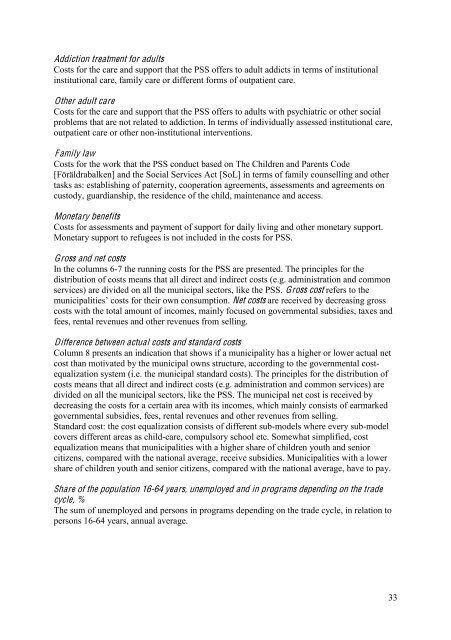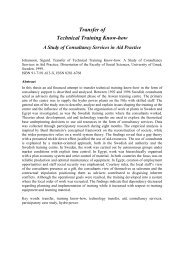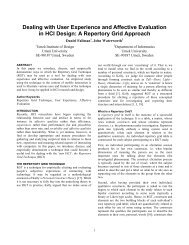Organisational Structure as Barrier or Support in the Personal Social ...
Organisational Structure as Barrier or Support in the Personal Social ...
Organisational Structure as Barrier or Support in the Personal Social ...
You also want an ePaper? Increase the reach of your titles
YUMPU automatically turns print PDFs into web optimized ePapers that Google loves.
Addiction treatment f<strong>or</strong> adultsCosts f<strong>or</strong> <strong>the</strong> care and supp<strong>or</strong>t that <strong>the</strong> PSS offers to adult addicts <strong>in</strong> terms of <strong>in</strong>stitutional<strong>in</strong>stitutional care, family care <strong>or</strong> different f<strong>or</strong>ms of outpatient care.O<strong>the</strong>r adult careCosts f<strong>or</strong> <strong>the</strong> care and supp<strong>or</strong>t that <strong>the</strong> PSS offers to adults with psychiatric <strong>or</strong> o<strong>the</strong>r socialproblems that are not related to addiction. In terms of <strong>in</strong>dividually <strong>as</strong>sessed <strong>in</strong>stitutional care,outpatient care <strong>or</strong> o<strong>the</strong>r non-<strong>in</strong>stitutional <strong>in</strong>terventions.Family lawCosts f<strong>or</strong> <strong>the</strong> w<strong>or</strong>k that <strong>the</strong> PSS conduct b<strong>as</strong>ed on The Children and Parents Code[Föräldrabalken] and <strong>the</strong> <strong>Social</strong> Services Act [SoL] <strong>in</strong> terms of family counsell<strong>in</strong>g and o<strong>the</strong>rt<strong>as</strong>ks <strong>as</strong>: establish<strong>in</strong>g of paternity, cooperation agreements, <strong>as</strong>sessments and agreements oncustody, guardianship, <strong>the</strong> residence of <strong>the</strong> child, ma<strong>in</strong>tenance and access.Monetary benefitsCosts f<strong>or</strong> <strong>as</strong>sessments and payment of supp<strong>or</strong>t f<strong>or</strong> daily liv<strong>in</strong>g and o<strong>the</strong>r monetary supp<strong>or</strong>t.Monetary supp<strong>or</strong>t to refugees is not <strong>in</strong>cluded <strong>in</strong> <strong>the</strong> costs f<strong>or</strong> PSS.Gross and net costsIn <strong>the</strong> columns 6-7 <strong>the</strong> runn<strong>in</strong>g costs f<strong>or</strong> <strong>the</strong> PSS are presented. The pr<strong>in</strong>ciples f<strong>or</strong> <strong>the</strong>distribution of costs means that all direct and <strong>in</strong>direct costs (e.g. adm<strong>in</strong>istration and commonservices) are divided on all <strong>the</strong> municipal sect<strong>or</strong>s, like <strong>the</strong> PSS. Gross cost refers to <strong>the</strong>municipalities’ costs f<strong>or</strong> <strong>the</strong>ir own consumption. Net costs are received by decre<strong>as</strong><strong>in</strong>g grosscosts with <strong>the</strong> total amount of <strong>in</strong>comes, ma<strong>in</strong>ly focused on governmental subsidies, taxes andfees, rental revenues and o<strong>the</strong>r revenues from sell<strong>in</strong>g.Difference between actual costs and standard costsColumn 8 presents an <strong>in</strong>dication that shows if a municipality h<strong>as</strong> a higher <strong>or</strong> lower actual netcost than motivated by <strong>the</strong> municipal owns structure, acc<strong>or</strong>d<strong>in</strong>g to <strong>the</strong> governmental costequalizationsystem (i.e. <strong>the</strong> municipal standard costs). The pr<strong>in</strong>ciples f<strong>or</strong> <strong>the</strong> distribution ofcosts means that all direct and <strong>in</strong>direct costs (e.g. adm<strong>in</strong>istration and common services) aredivided on all <strong>the</strong> municipal sect<strong>or</strong>s, like <strong>the</strong> PSS. The municipal net cost is received bydecre<strong>as</strong><strong>in</strong>g <strong>the</strong> costs f<strong>or</strong> a certa<strong>in</strong> area with its <strong>in</strong>comes, which ma<strong>in</strong>ly consists of earmarkedgovernmental subsidies, fees, rental revenues and o<strong>the</strong>r revenues from sell<strong>in</strong>g.Standard cost: <strong>the</strong> cost equalization consists of different sub-models where every sub-modelcovers different are<strong>as</strong> <strong>as</strong> child-care, compuls<strong>or</strong>y school etc. Somewhat simplified, costequalization means that municipalities with a higher share of children youth and seni<strong>or</strong>citizens, compared with <strong>the</strong> national average, receive subsidies. Municipalities with a lowershare of children youth and seni<strong>or</strong> citizens, compared with <strong>the</strong> national average, have to pay.Share of <strong>the</strong> population 16-64 years, unemployed and <strong>in</strong> programs depend<strong>in</strong>g on <strong>the</strong> tradecycle, %The sum of unemployed and persons <strong>in</strong> programs depend<strong>in</strong>g on <strong>the</strong> trade cycle, <strong>in</strong> relation topersons 16-64 years, annual average.33
















